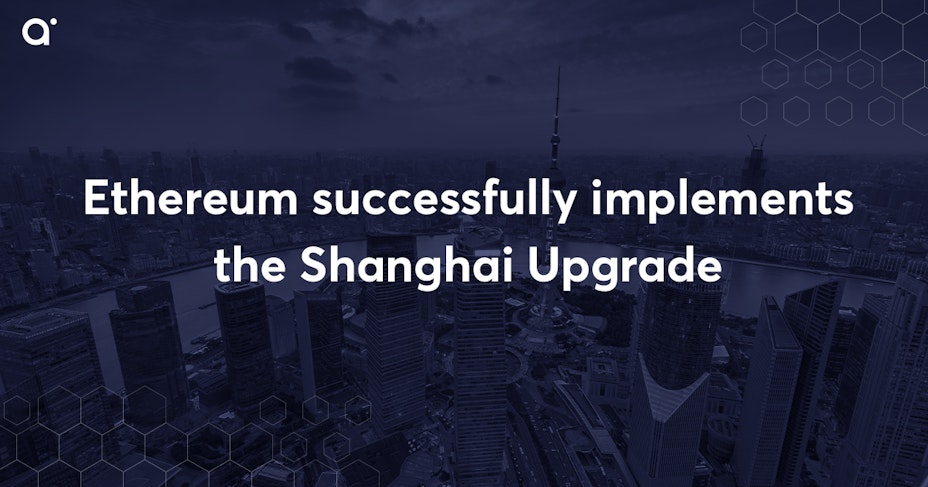Ethereum successfully implements the Shanghai Upgrade
- 5 minute read

On 12 April 2023, Ethereum implemented the long-awaited Shanghai update. What is it and why is the update important for Ethereum?

Table of Contents
- What is the Ethereum Shanghai update?
- Advantages of the Ethereum Shanghai Update
- The effect of the update on the Ethereum price
- Conclusion
About the Shanghai update
- The Shanghai update was implemented 12 April 2023
- The Shanghai update completes the transition to PoS
- Execution environments (EEs) make building and implementing smart contracts easier, safer and more cost-effective.
What is the Ethereum Shanghai update?
The Ethereum Shanghai update is a major upgrade to the Ethereum blockchain that will complete the network's transition from Proof-of-Work (PoW) to Proof-of-Stake (PoS). The upgrade, codenamed "Shanghai", was implemented at 22:27 UTC on April 12th, 2023. This upgrade enables the "unstaking" of nearly 18 million ETH, which is about 15% of all Ether in circulation.
The upgrade could have a big impact on the price of Ether, as the staked ETH coins are now withdrawable. In addition, the Shanghai update introduces a new type of smart contract known as execution environments (EEs). EEs are designed to make building and implementing smart contracts easier, safer and more cost-effective.
Shanghai update completes transition to PoS
The Shanghai update was the latest step in Ethereum's transition from PoW to PoS. The PoS algorithm is seen as a more energy-efficient way to verify transactions. Ethereum long used the Proof-of-Work consensus algorithm, but launched the Beacon Chain in 2020. In September 2022, the mainnet merged with the Beacon Chain, with the mainnet also switching to Proof-of-Stake. Users could stake their ETH after the launch of the Beacon Chain. However, they could not withdraw them. Now with the Shanghai update, these validators can withdraw their Ether.
A limit on withdrawals
Investors were worried that once the update was implemented, there would be a big selling pressure. Especially since about 15% of existing ETH were staked. The selling pressure could reach $2.4 billion. It has now become clear that there is a limit to take-up. An estimate from Into The Block indicates that it will take about 60 days to unstake 20% of Ether.
Advantages of the Ethereum Shanghai Update
One of the primary benefits of the Ethereum Shanghai update is its new proof-of-stake consensus algorithm. This algorithm enhances the Ethereum network's security, scalability, energy efficiency, and speed. With the new algorithm, Ethereum can better handle a higher number of transactions per second, leading to reduced gas fees and faster transaction settlement times.
Another advantage is the introduction of execution environments (EES). EEs allow developers to design and deploy smart contracts that are specialized for a particular use case, reducing the risk of errors and improving security. EEs also make it possible to build dApps that run on multiple networks at once, allowing for seamless integration between different blockchain ecosystems.
The effect of the update on the Ethereum price
Investors feared there would be a sell-off after the update. A day after the update, we see the Ethereum price reacting positively to the Shanghai update. Currently, the price is at this year's all-time high and Ether is up over 6.5% on a 24-hour basis. However, the price is now encountering resistance at the $2,000 mark.
Conclusion
All in all, the Ethereum Shanghai update is an important upgrade for the Ethereum network. Its impact is expected to increase network security, create scalability and lead to lower gas costs and faster transaction times. With EEs and the completion of Proof-of-Stake, the Ethereum network has taken another step towards becoming the most robust blockchain platform for dApp development. We hope this blog post has given you a better understanding of Ethereum and what the Shanghai update has in store. As always, stay tuned to the latest developments in the world of cryptocurrencies to make informed investment decisions.


